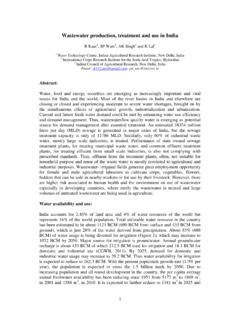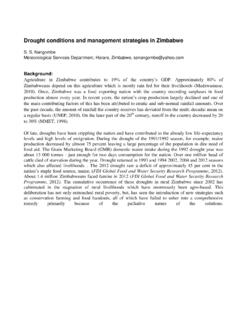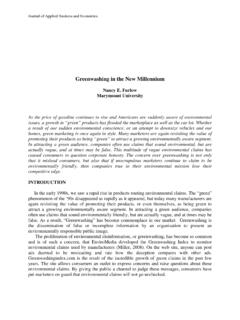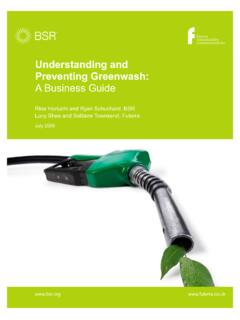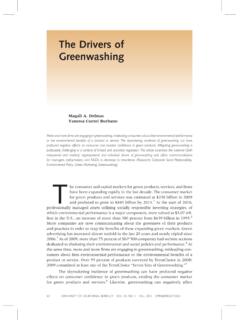Transcription of Wastewater Production, Treatment, and Use in Malaysia
1 Page 1 of 6 Wastewater production , treatment , and Use in Malaysia Engku Azman Tuan Mat1, Jamil Shaari2, and Voon Kok How3 Wastewater production and treatment Malaysia has a population of million based on the Report of Census 2010 by the Department of Statistics. The estimated volume of Wastewater generated by municipal and industrial sectors is billion cubic meters per year. The proportions of population equivalent (PE) served by the various sewerage systems are shown in Figure 1. Figure 1: proportions of population equivalent (PE) served by the various sewerage systems4 According to Indah Water Konsortium (the country s main sewerage operator), the dominant Wastewater treatment types are preliminary (removal of rags, rubbish, grit, oil, grease), primary (removal of settleable and floatable materials), and secondary treatment (biological treatment to remove organic and suspended solids).
2 At the moment, there is no plan to build tertiary treatment systems in Malaysia . The focus has been providing a basic standard of preliminary, primary, and secondary treatment . 1 Ministry of Health, Engineering Services Division, Putrajaya, Malaysia , 2 Ministry of Agriculture and Agro-based Industries, Putrajaya, Malaysia 3 Ministry of Health, Engineering Services Division, Putrajaya, Malaysia 4 Estimated based on data from the Malaysia Water Industry Guide (MWIG) 2012, National Water Services Commission s Malaysia Sewerage Industry Guidelines 2009, Sarawak Sewerage Services Department s Inventory of Wastewater treatment Facility 2011, and MOH s Water Supply & Environmental Sanitation Program Annual Report 2011. Page 2 of 6 The major constraints to Wastewater treatment faced by Malaysia are as follows: At the present scenario, low sewerage tariff is unable to support the high operation and maintenance costs.
3 Non-compliance or mediocre compliance are mainly caused by high influent of oil and grease (O&G) discharged into STPs serving industrial, commercial areas and food related business premises that do not have grease traps or do not maintain grease traps adequately. Other contributory factors are excessive discharge of soaps, detergents and other cleaning agents into sewerage system. Sewerage services collection by operators is not conducive as it is unfortunate that many Malaysians fail to realize the importance of sewage management with regards to a safer environment. To curb this government has initiated proposal to introduce joint billing for water supply and sewerage services. The dynamics of the sewerage industry where sewerage infrastructures are constructed by private developers and handed over to the public operator (for operations and maintenance) opens up the risk factor of quality being compromised, which would subsequently have impact on the treatment processes and operations.
4 Wastewater use/disposal Currently there is no information on the area of food crops irrigated with Wastewater as the Government of Malaysian has yet to have a policy on the reuse of Wastewater whether treated or untreated, for irrigation. The average annual rainfall is more than 2,800mm and the estimated annual total surface water is 566 billion cubic meters, of which only 10% is readily available to satisfy the demands of agriculture, domestic, industry and power sectors (Mohd. Azhari, ). Although the volume of surface water is able to meet the demand of various uses and applications at the moment, there were few occasions in the past where the country had faced adverse water shortage due to extreme drought condition during the dry season. It is mandatory for Wastewater in urban areas and townships to be treated before discharged into surface waters.
5 The quality of effluent from treatment plants is regulated by the Environmental Quality Act 1974 and its regulations such as the Environmental Quality (Sewage) Regulations 2009 and Environmental Quality (Industrial Effluent) Regulations 2009. In most rural areas, pour flush latrines are introduced. Therefore, there is no direct use of Wastewater in the agriculture sector as treated Wastewater effluent had undergone dilution when coming into contact with surface waters. In the Bio-Effluent and Bio-Solids Pilot Project, the Port Dickson Local Authority (PDLA) has agreed to use bio-solids and bio-effluent generated from the public sewage treatment plant for landscaping purpose. PDLA has embarked on a partnership with the sewerage operator to utilize its green by-products in support of the Government s green Initiatives. PDLA is also persistently seeking to cut down on the usage of precious potable water and achieve cost savings by reducing the use of commercial fertilizers for landscaping with the reuse of bio-solids and bio-effluent.
6 Page 3 of 6 According to the Sustainability Report 2011 of Indah Water Konsortium, the organization has been practicing the reuse of sewage by-products at 13 of their regional plants as an initial effort to conserving water, energy and the environment. The reuse of the treated effluent from their plants is currently confined to internal housekeeping or non-potable use, such as STP compound cleaning, vehicles cleaning and watering of plants for landscaping purpose. The treated effluent is also recycled as make up water for polymer preparation as well as for water filling or refilling into jettors or sewer cleaning vehicles for sewer cleaning maintenance works and clearing of blockages. Policies and institutional set-up and needs for Wastewater management The National Water Services Commission (SPAN) was set-up to regulate the water supply services and sewerage services industry through fair, effective, and transparent implementation of Water Services Industry Act 2006 (Act 655) towards a sustainable, reliable and affordable water services for all.
7 Amongst the objective of WSIA is to establish the framework to regulatory intervention and to promote the National Policy Objective for the water supply end sewerage services industry. The Sewerage Services Department is responsible for the implementation of STP projects and act as advisory body to the Ministry of Energy, green Technology, and Water pertaining to sewerage issues. Indah Water Konsortium, a company owned by the Minister of Finance Incorporated, is Malaysia 's national sewerage company which has been entrusted with the task of developing and maintaining a modern and efficient sewerage system for all Malaysians. The Department of Environment (DOE) is the regulatory body for Wastewater effluent quality through the Environmental Quality Act 1974 and its regulations such as the Environmental Quality (Sewage) Regulations 2009 and Environmental Quality (Industrial Effluent) Regulations 2009.
8 The quality of surface water is determined by the Water Quality Index and the suitability of surface water for irrigation is based on the designated classifications in the National Water Quality Standards for Malaysia established by DOE. The Ministry of Health is the regulatory body for food safety. Food safety is enforced through Food Act 1983 (Act 281) and Food Regulations 1985. Food unfit for human consumption and food that is contaminated with pathogenic micro-organisms and their toxins are not allowed to be imported, prepared, advertised for sale, or sold for consumption. Page 4 of 6 Research/practice on different aspects of Wastewater Ongoing collaborative researches by Indah Water Konsortium with University Putra of Malaysia are as follows: i) Sewage sludge as fertilizer for various crops to assess the potential application of treated sludge as fertilizer and/or soil amendment.
9 These studies enable IWK to develop an inexpensive method of converting sludge to organic stabilized fertilizers for commercial ornamental plants or other land application. ii) Sludge as soil amendment to assess the potential use of treated sludge as soil amendment. The product can be useful for reconditioning of sandy and degraded soils for agricultural and forestry development as well as for ground bioengineering for erosion control and slope stabilization. Nonetheless, development of sewage sludge as soil amendment requires sufficient knowledge on the characteristics of types of sludge produced so as to make an informed judgment on the long-term impact of its utilization. iii) Co-composting of sewage sludge & municipal solid waste to develop a technology for producing good quality compost in a short time period under controlled conditions from sewage sludge and municipal solid waste for use as soil conditioner/fertilizer.
10 Results from this study shall enhance development of a viable technology for the commercial implementation of a composting plant in converting sludge and municipal waste to good quality compost. iv) Application of sewage sludge in forest rehabilitation & regeneration to elucidate the efficiency of using sewage sludge in rehabilitation of degraded forest and ex-mining land. The study will focus on the effects of sewage sludge application on the soil water chemistry and water quality, along with the monitoring of growth responses of the forest plantation species due to application of sewage sludge. The study is aimed to develop an environmentally friendly strategy on applying the sewage solids onto the forest area and ex-mining land and at the same time demonstrate that IWK is doing its part in preserving the environment for the future generation.
